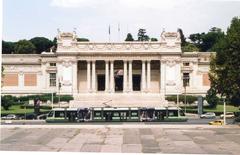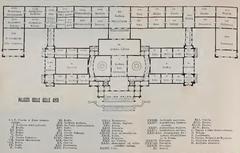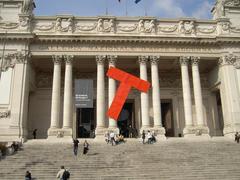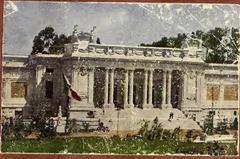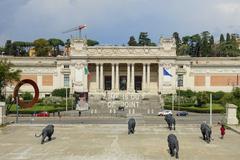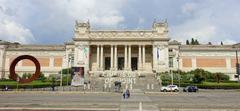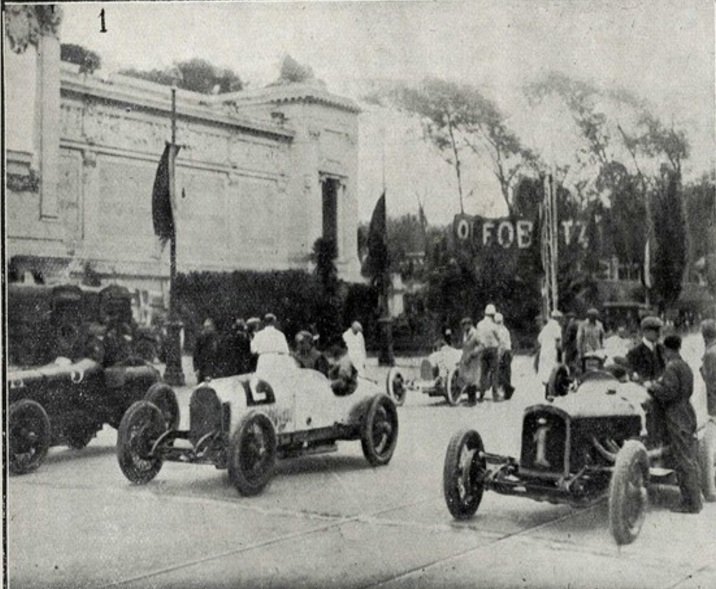
Galleria Nazionale d’Arte Moderna e Contemporanea Rome: Visiting Hours, Tickets, and Visitor Guide
Date: 14/06/2025
Introduction
Located in the heart of Rome, the Galleria Nazionale d’Arte Moderna e Contemporanea (GNAM) is Italy’s foremost institution dedicated to modern and contemporary art. Founded in 1883 during a period of national cultural revival, GNAM has become a vital hub chronicling over two centuries of artistic innovation. Housed in the iconic Palazzo delle Belle Arti—a neoclassical structure designed by Cesare Bazzani and completed in 1915—the museum offers a deep dive into Italian and international art movements, from Neoclassicism and Futurism to Arte Povera and beyond. With a collection of more than 20,000 works by luminaries such as Antonio Canova, Giacomo Balla, Giorgio de Chirico, Vincent van Gogh, and Jackson Pollock, GNAM exemplifies the ongoing dialogue between Italy’s rich artistic heritage and global modernism.
GNAM’s visitor experience is enhanced by extensive accessibility features, a variety of guided tours, and its prime location adjacent to Villa Borghese park—combining artistic, historical, and natural attractions. Whether you are an art lover or a curious traveler, this guide covers GNAM’s history, opening hours, ticketing options, exhibitions, and nearby sites, ensuring you have the information needed for a memorable visit (Wikipedia, Lagallerianazionale.com, SpottingHistory, Rome.net).
Table of Contents
- Introduction
- History and Founding
- Architectural Significance and Location
- Development of the Collection
- Role in Italian and International Art
- Visitor Information
- Nearby Attractions
- Cultural and Social Impact
- Expansion and Partnerships
- GNAM in the Contemporary Era
- Visitor Experience and Legacy
- Frequently Asked Questions
- Planning Your Visit
- References
History and Founding
Established in 1883, the Galleria Nazionale d’Arte Moderna e Contemporanea (GNAM) was conceived as a response to Italy’s unification, led by Guido Baccelli, then Minister of Public Instruction. Its purpose was to showcase and promote contemporary Italian art, contributing to the construction of a unified national identity. Originally housed in the Palazzo delle Esposizioni, the gallery quickly outgrew this space due to the rapid expansion of its collection. In 1911, to coincide with the 50th anniversary of Italian unification, GNAM moved to its current location in the Palazzo delle Belle Arti (Wikipedia, Museos.com).
Architectural Significance and Location
The Palazzo delle Belle Arti, situated at 113 Via delle Belle Arti beside Villa Borghese, is a remarkable example of early 20th-century neoclassical architecture. Designed by Cesare Bazzani, the building was inaugurated for the 1911 International Fine Arts Exhibition. Its façade features intricate neoclassical friezes by Ermenegildo Luppi, Adolfo Laurenti, and Giovanni Prini, along with bronze figures of Fame by Adolfo Pantaresi and Albino Candoni. The grand entrance, marked by a ceremonial staircase and Corinthian columns, sets a tone of artistic reverence (Britannica, SpottingHistory).
Inside, GNAM offers 55 rooms spanning around 20,000 square meters, with wide corridors and ample natural light. The layout supports both chronological and thematic exploration, creating an immersive environment for all visitors (Rome.info).
Development of the Collection
With approximately 20,000 works, GNAM holds Italy’s largest collection devoted exclusively to modern and contemporary art (Lagallerianazionale.com). The collection encompasses 19th-century Neoclassicism, Impressionism, Futurism, Surrealism, the Novecento movement, the Roman School, and the latest trends in conceptual and installation art.
The museum’s holdings are not limited to Italian artists—its international collection includes works by Vincent van Gogh, Claude Monet, Gustav Klimt, Jackson Pollock, Marcel Duchamp, Andy Warhol, and Alexander Calder, among others (Rome.net). Thematic installations encourage visitors to make connections across periods and styles (EMST).
Role in Italian and International Art
GNAM was envisioned as a dynamic institution, continually acquiring new works and reflecting the evolving landscape of Italian and international art. Its 75 exhibition halls are organized both thematically and chronologically, tracing the development of major artistic movements. The ground floor focuses on the 19th century, while the upper floor highlights 20th- and 21st-century innovation (Museopertutti.org, Rome.net).
Recent exhibitions, such as “Il Tempo del Futurismo” (2024–2025), have demonstrated GNAM’s ongoing commitment to multidisciplinary and international programming (GBOpera).
Visitor Information
Visiting Hours
- Tuesday–Sunday: 8:30 AM–7:30 PM (last admission at 6:30 PM)
- Closed: Mondays and select public holidays
- Tip: Always check the official GNAM website for updates, as hours may change during holidays or special events.
Tickets and Admission
- Standard Admission: €10
- Reduced Admission: €5 (EU citizens aged 18–25, students, select groups)
- Free Admission: Children under 18, people with disabilities and companions, first Sunday of each month (reservation required), MIC Card holders
- Booking: Online reservation is highly recommended to secure your preferred time slot and avoid queues. Tickets are valid for a three-hour entry window, allowing re-entry during that period (Lagallerianazionale.com).
Guided Tours and Special Events
- Multilingual Guided Tours: Available by advance booking for an additional fee
- Workshops and Lectures: Regularly scheduled for adults, children, and schools
- Special Exhibitions: Check the official calendar for current and upcoming shows
Accessibility
- Wheelchair Access: Elevators, ramps, accessible restrooms, and wheelchairs available
- Tactile Tours: For visitors with visual impairments (by prior arrangement)
- Signage: Multilingual and accessible throughout the museum
Photography
- Permitted: Non-flash photography for personal use
- Restrictions: No tripods or flash; professional photography requires authorization
Directions
- Address: Viale delle Belle Arti, 131, 00197 Rome, Italy
- Metro: Line A, Flaminio (then a short walk)
- Bus: Lines 88, 95, 490, and 495
- Tram: Tram 2 (Flaminio stop)
- Parking: Limited; public transport recommended
View GNAM location on Google Maps
Nearby Attractions
Enhance your visit by exploring these nearby sites:
- Villa Borghese Gardens: Landscaped park with fountains, sculptures, and walking paths
- Galleria Borghese: Renowned for its Baroque masterpieces
- Piazza di Spagna and the Spanish Steps: Iconic Roman landmarks
- Pincian Hill: Offers panoramic city views
Cultural and Social Impact
GNAM has played a significant role in shaping Italy’s cultural identity by fostering artistic dialogue and supporting both established and emerging artists. Its accessible, visitor-friendly design and educational programming make it a model for inclusive, immersive art experiences (Rome-Roma.net, Museopertutti.org).
Expansion and Partnerships
GNAM’s influence extends through collaborations with other museums, including the Museo Boncompagni Ludovisi, Museo Hendrik C. Andersen, Raccoltà Manzù, and Museo Mario Praz. These affiliations enrich the gallery’s offerings and reinforce its central role in Italy’s cultural landscape (Wikipedia).
GNAM in the Contemporary Era
Today, GNAM stands as Italy’s only national museum dedicated exclusively to modern and contemporary art. Its collection, exhibitions, and educational initiatives ensure it remains at the forefront of both national and international cultural discourse (Lagallerianazionale.com).
Visitor Experience and Legacy
A visit to GNAM is both an artistic and architectural experience, blending Italy’s modern art heritage with innovative curatorial practices. Its proximity to Villa Borghese and other landmarks makes it a must-see destination in Rome. GNAM’s ongoing influence is evident in its contributions to public education, cultural vibrancy, and international art dialogues (Rome.net).
Frequently Asked Questions
Q: What are the Galleria Nazionale’s opening hours?
A: Tuesday to Sunday, 8:30 AM–7:30 PM; closed Mondays.
Q: How do I buy tickets?
A: Purchase online via the official website or at the museum entrance. Online booking is advised.
Q: Is GNAM accessible?
A: Yes, with ramps, elevators, accessible restrooms, and tactile tours.
Q: Can I take photos?
A: Yes, non-flash photography for personal use is permitted.
Q: Are guided tours available?
A: Yes, in several languages by advance reservation.
Q: What are nearby attractions?
A: Villa Borghese Gardens, Galleria Borghese, Piazza di Spagna.
Planning Your Visit
- Book tickets in advance for your preferred entry time
- Check the museum layout to plan your route; the thematic organization encourages exploration
- Combine your visit with a stroll in Villa Borghese or a stop at nearby museums
- Review the latest exhibitions and visitor updates on the official GNAM website
- Download the Audiala app for audio tours, insider tips, and updates on Rome’s museums
References and Useful Links
- Galleria Nazionale d’Arte Moderna e Contemporanea (GNAM) Rome: Visiting Hours, Tickets & History
- Galleria Nazionale d’Arte Moderna e Contemporanea - Museo
- Exploring the Architectural Marvel of Galleria Nazionale d’Arte Moderna in Rome: Visiting Hours, Tickets, and More
- Galleria Nazionale Rome: Visiting Hours, Tickets, and Highlights of Italy’s Premier Modern Art Museum
- National Gallery of Modern and Contemporary Art, Rome
- Galleria Nazionale d’Arte Moderna e Contemporanea - Visitor Experience and Practical Information
- Galleria Nazionale d’Arte Moderna e Contemporanea - Il Tempo del Futurismo Exhibition

